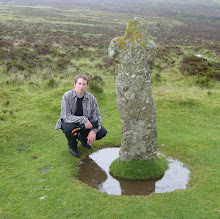
The White Horse of Uffington is local to me and it was the inspiration for G K Chesterton's epic poem "The Ballad of the White Horse". This one of the last great epic poems in English Literature.
Before the gods that made the gods
Had seen their sunrise pass,
The White Horse of the White Horse Vale
Was cut out of the grass.
Before the gods that made the gods
Had drunk at dawn their fill,
The White Horse of the White Horse Vale
Was hoary on the hill.
 Did a long-ish walk this weekend around the folklore rich are of the White Horse and Uffington Monuments. We parked in the National Trust car park and walked up the gentle slope to stand near the white horse.
Did a long-ish walk this weekend around the folklore rich are of the White Horse and Uffington Monuments. We parked in the National Trust car park and walked up the gentle slope to stand near the white horse.
We passed some strange ripples in the valley known as the "giant's steps". These are apparently a natural earth formation caused by the melting of water in the Ice Age. (Not the ice giants!) The valley below the horse is called the manger and is said to be where the horse goes down to drink.

According to legend, the hill below the horse is where St George slayed the dragon. The legend says no grass with grow on this hill as a result of the dragon's blood poisoning it. We walked on the hill, and sure enough there is hardly any grass growing on its top.
 We walked from here up to Uffington castle, which an ancient hill fort and the highest point in Oxfordshire, and then walked the ridgeway, the ancient roman road, towards Waylands Smith.
We walked from here up to Uffington castle, which an ancient hill fort and the highest point in Oxfordshire, and then walked the ridgeway, the ancient roman road, towards Waylands Smith.
 Our pilgrimage to Waylands Smith took us on many diversions most notably the village of Woolstone where we found a really quaint old mediaeval church. I thought it was a beautiful place and loved the gothic interior. This is the sort of building the Pre Raphaelite writer William Morris would have admired. He often visited Great Coxwell Barn, a large mediaeval stone barn which is also in the area and the pre raphaelites were inspired by mediaeval arts and crafts.
Our pilgrimage to Waylands Smith took us on many diversions most notably the village of Woolstone where we found a really quaint old mediaeval church. I thought it was a beautiful place and loved the gothic interior. This is the sort of building the Pre Raphaelite writer William Morris would have admired. He often visited Great Coxwell Barn, a large mediaeval stone barn which is also in the area and the pre raphaelites were inspired by mediaeval arts and crafts.






On the way down to Woolstone we saw a real white horse:

Eventually we arrived at Waylands Smith where we left a penny for the invisible blacksmith to shod our invisible horse. The Waylands Smith does look a bit like a hobbit house and I think there can be no doubt that Tolkien was probably influenced by monuments such as this.
We then took a diversion through the very strang valley called Oddstone Coombes, looking out over the valley through the gnarled and strange looking beech trees.

We then followed the ridgeway on a long pleasant stretch of track all the way back to the distant landmark of Uffington castle, where we arrived just in time to watch the sunset.



I love the pictures from the old church. Old churches have a distict feel to them. The interior is very nice, thanks.
ReplyDelete